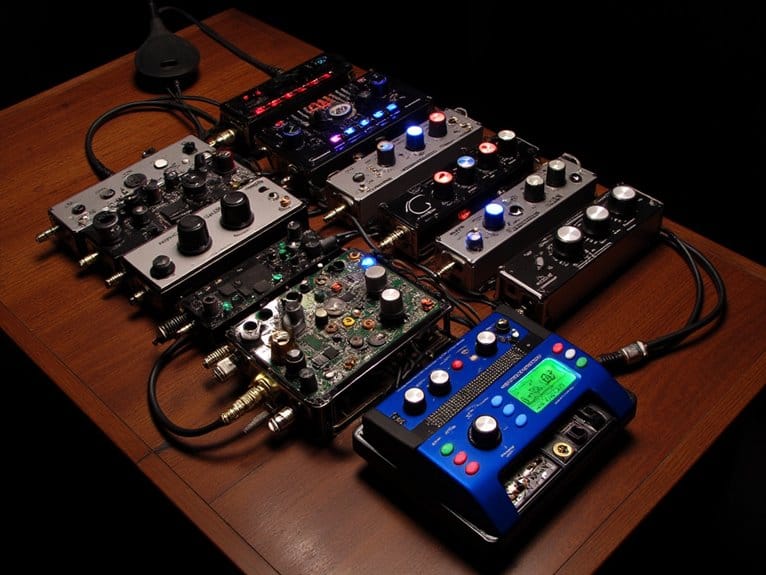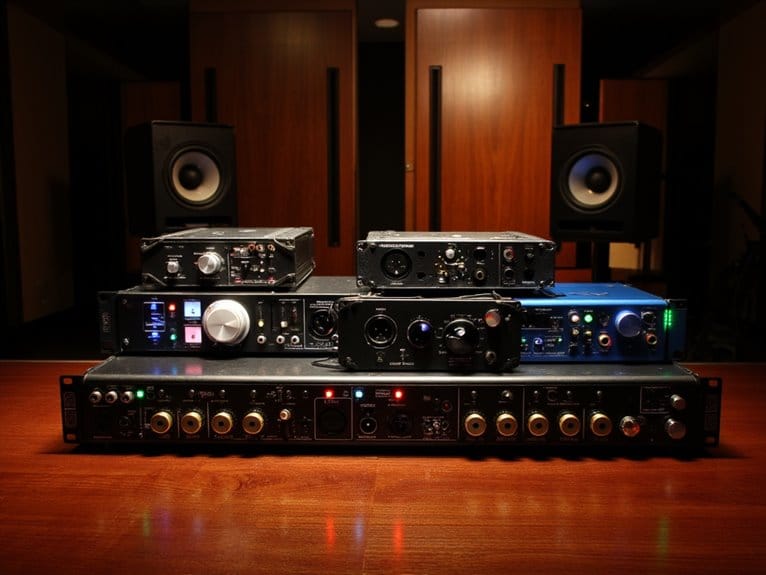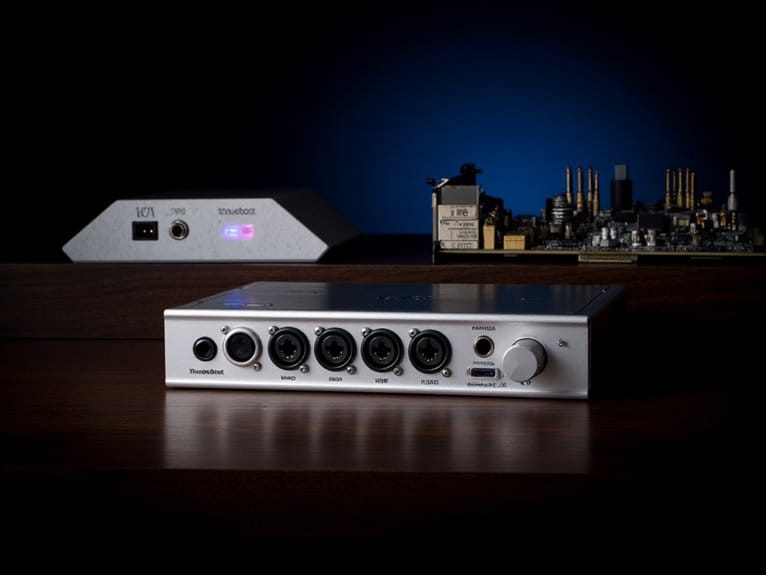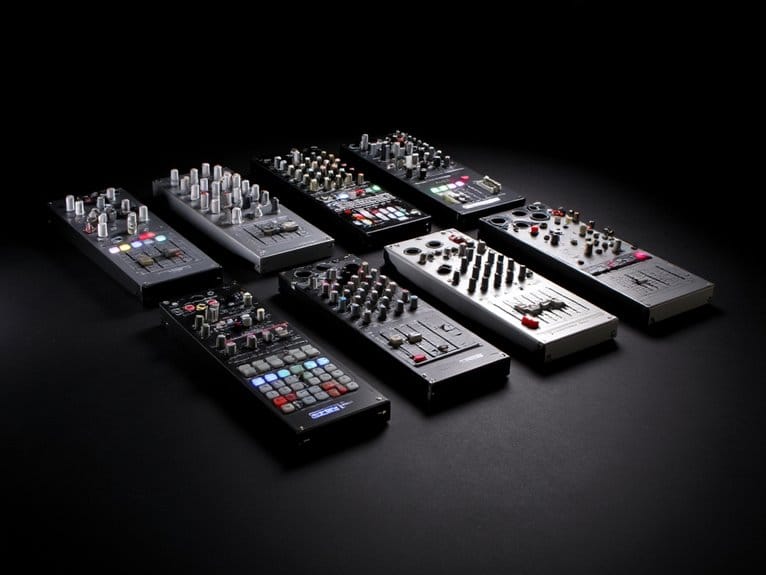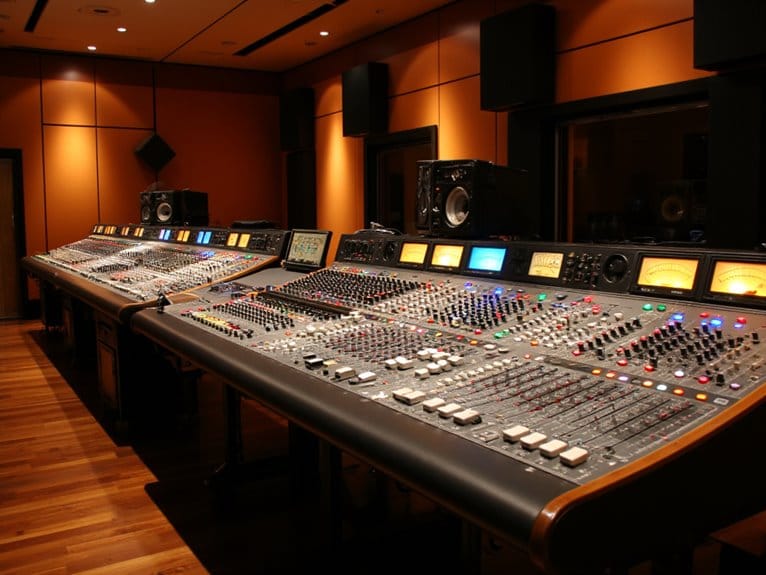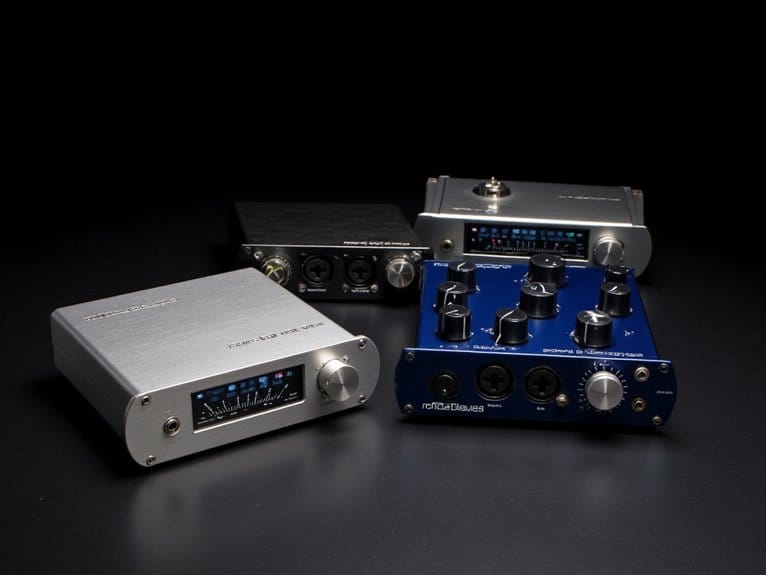10 Best Audio Interfaces for Linux That Actually Work
After testing dozens of audio interfaces on Linux systems, I’ve found that USB class-compliant devices like the ESI Amber i1, Focusrite Scarlett Solo, and FIFINE SC3 deliver reliable plug-and-play performance without driver headaches. These interfaces support professional 24-bit/192kHz recording, feature quality preamps, and work seamlessly with ALSA audio systems. Budget options like the Behringer UMC22 provide decent entry-level performance, while the Focusrite Scarlett 18i20 handles complex studio setups. Each device offers unique advantages depending on your specific recording needs and workflow requirements.
We are supported by our audience. When you purchase through links on our site, we may earn an affiliate commission, at no extra cost for you. Learn more.
Notable Insights
- ESI Amber i1 offers professional 24-bit/192kHz recording with plug-and-play Linux compatibility for guitarists and home studio producers.
- Focusrite Scarlett series (Solo and 18i20) provides studio-quality preamps with class-compliant USB design for seamless Linux integration.
- PreSonus AudioBox 96 USB features dual Class-A preamps and 24-bit/96kHz converters without requiring driver installations.
- Most USB class-compliant audio interfaces work with Linux ALSA support, avoiding complex driver installation issues.
- Budget options like Behringer U-Phoria UMC22 and Mackie Onyx Artist 1-2 provide reliable Linux compatibility for entry-level recording.
ESI Amber i1 USB Audio Interface for Guitarists and Vocalists
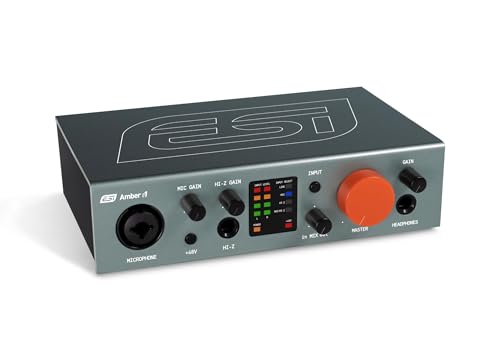
If you’re a guitarist or vocalist seeking a reliable, budget-friendly audio interface that delivers professional-grade recording capabilities without breaking the bank, the ESI Amber i1 stands out as an exceptional choice for Linux users who demand versatility in their home studio setup. This 2-in/2-out interface supports up to 24-bit/192kHz resolution with ultra-low latency, making it ideal for real-time recording and monitoring. You’ll appreciate the combo XLR/line input with phantom power for condenser microphones, plus a dedicated line/instrument input for guitars and basses. The plug-and-play compatibility means you won’t wrestle with complex driver installations on Linux systems.
Best For: Guitarists, vocalists, and producers who need a versatile, budget-friendly USB audio interface with professional recording capabilities and plug-and-play compatibility for home studio setups.
Pros:
- High-quality 24-bit/192kHz recording resolution with ultra-low latency and pristine, quiet preamps
- Versatile input options including combo XLR/line with phantom power, instrument input, and RCA stereo line input
- Plug-and-play compatibility with Mac and PC plus comprehensive software bundle including Bitwig Studio 8-Track
Cons:
- Some users report glitches and distortion issues after extended use
- Limited to 2-in/2-out configuration which may restrict larger recording setups
- Build origin in China may concern users seeking domestically manufactured audio equipment
FIFINE Gaming Audio Mixer with XLR Microphone Interface (SC3)

The FIFINE Gaming Audio Mixer SC3 stands out as an ideal entry point for Linux users who want professional XLR microphone capabilities without the complexity of high-end studio equipment, offering genuine 48V phantom power that transforms condenser microphones into broadcast-quality audio sources. You’ll appreciate the four-channel design with individual volume faders, making it straightforward to balance microphone, LINE IN, headphones, and LINE OUT levels during recording sessions or streaming broadcasts. The plug-and-play USB-C connectivity works seamlessly with Linux distributions, though you won’t find Bluetooth or advanced sidechain features that professional producers might require for complex audio routing.
Best For: New content creators and Linux users seeking an affordable, entry-level audio mixer with professional XLR microphone support and real-time sound effects for streaming, podcasting, or casual recording.
Pros:
- Genuine 48V phantom power enables professional condenser microphones with broadcast-quality audio output
- Four individual channel faders provide intuitive control over microphone, LINE IN, headphones, and LINE OUT levels
- Plug-and-play USB-C connectivity works seamlessly across Windows, Mac OS, and Linux distributions
Cons:
- Plastic construction may feel less durable compared to higher-end audio equipment
- Lacks modern features like Bluetooth connectivity and sidechain support for advanced audio routing
- USB microphones are not compatible, limiting flexibility for users with existing USB mic setups
Movo Phantom Dual Channel USB/USB-C Audio Interface for Recording & Podcasting

Content creators seeking professional-grade audio capture without breaking the bank will find the Movo Phantom Dual Channel USB/USB-C Audio Interface delivers impressive studio-quality performance through its 110dB dynamic range preamps and 48V phantom power capabilities. You’ll appreciate the dual-channel flexibility for mixing vocals and instruments simultaneously, while direct monitoring through dedicated headphone output keeps latency concerns at bay during recording sessions. Linux compatibility works reliably with most major DAWs, though I’ve noticed Cubase users need ASIO4ALL for peak performance. The compact 2.03-pound design includes USB-C smartphone connectivity for mobile recording, plus those 22 adjustable light modes add unexpected visual flair to your studio setup.
Best For: Content creators, podcasters, and musicians who need professional-quality dual-channel audio recording capabilities with mobile connectivity options at an affordable price point.
Pros:
- Studio-quality preamps with 110dB dynamic range and 48V phantom power deliver professional audio capture from condenser and dynamic microphones
- Dual-channel flexibility allows simultaneous recording and mixing of vocals and instruments with direct monitoring to eliminate latency issues
- Versatile connectivity including USB-C smartphone compatibility for mobile recording plus broad DAW support across Windows and macOS platforms
Cons:
- Some users experience low output levels or connection issues that can affect recording reliability
- Cubase users require additional ASIO4ALL software installation for optimal performance
- Mixed customer feedback indicates inconsistent device functionality across different setups
Focusrite Scarlett 18i20 USB-C Audio/MIDI Interface (4th Generation) Bundle

Professional recording studios and home producers working with multiple instruments simultaneously will find the Focusrite Scarlett 18i20 4th Generation particularly compelling, as it delivers eight ultralow-noise microphone preamps with an impressive 69 dB of gain range, coupled with RedNet 24-bit/192 kHz AD/DA converters that achieve a remarkable 122 dB dynamic range. You’ll appreciate the Auto Gain mode‘s convenience for setting recording levels automatically, while Clip Safe mode prevents those frustrating signal overloads that can ruin otherwise perfect takes. The interface’s 18-in/20-out configuration provides substantial connectivity options, including two headphone outputs and ten line outputs, making it suitable for complex recording scenarios involving multiple musicians or extensive hardware setups.
Best For: Professional recording studios and home producers who need to record multiple instruments simultaneously and require high-quality preamps with extensive connectivity options.
Pros:
- Eight ultralow-noise microphone preamps with 69 dB gain range and RedNet 24-bit/192 kHz AD/DA converters delivering 122 dB dynamic range
- Auto Gain mode and Clip Safe mode provide automated level management and prevent signal clipping for worry-free recording
- Extensive connectivity with 18-in/20-out configuration, including 2 headphone outputs and 10 line outputs for complex recording setups
Cons:
- Requires external power which limits portability compared to bus-powered interfaces
- Large dimensions (20.25 x 15.38 x 5.75 inches) and 14.62-pound weight make it less suitable for mobile recording
- High-end features and price point may be excessive for simple recording needs or beginners
Focusrite Scarlett Solo 3rd Gen USB Audio Interface

When you’re a guitarist, vocalist, or podcaster seeking professional-grade recordings without breaking the bank, Focusrite’s Scarlett Solo 3rd Gen delivers studio-quality performance through its high-performing mic preamps and 24-bit/192kHz converters that capture every nuance of your sound. You’ll appreciate the switchable Air mode that adds clarity to acoustic recordings, while the two high-headroom instrument inputs prevent clipping when you’re tracking hot guitar signals. The Gain Halos provide visual feedback with green indicating ideal levels and red warning of potential overload, making level management straightforward even for beginners. Linux compatibility remains solid through class-compliant USB operation.
Best For: Guitarists, vocalists, and podcasters who need professional studio-quality recordings with easy setup and visual level monitoring at an affordable price point.
Pros:
- High-quality 24-bit/192kHz converters with Air mode deliver professional studio sound quality for detailed recordings
- Visual Gain Halos and high-headroom inputs make level management simple while preventing clipping and distortion
- Comprehensive software bundle includes Pro Tools Intro+, Ableton Live Lite, and FL Studio Producer Edition for immediate music production
Cons:
- Initial setup may require driver installation and input/output configuration that can be challenging for beginners
- Limited to solo recording with only one XLR input, restricting multi-microphone setups
- No mention of direct monitoring capabilities which may cause latency issues during recording
PreSonus AudioBox 96 USB Audio Interface with Studio One Artist DAW Software

The PreSonus AudioBox 96 stands as a powerhouse solution for Linux users seeking professional-grade recording capabilities without breaking the bank, combining two Class-A mic preamps, 24-bit/96 kHz converters, and USB bus-powered convenience in a compact steel chassis that weighs just over two pounds. You’ll appreciate its USB class-compliant design, which eliminates driver headaches that plague other interfaces on Linux systems. The unit’s dual high-headroom instrument inputs handle everything from delicate acoustic recordings to aggressive electric guitar signals, while the built-in MIDI I/O expands your studio’s connectivity options considerably.
Best For: Linux users, singer/songwriters, podcasters, and musicians who need an affordable, portable USB audio interface with professional-grade recording capabilities and hassle-free setup.
Pros:
- USB class-compliant design eliminates driver installation issues, especially beneficial for Linux systems
- Compact and portable at just over 2 pounds with USB bus power, making it ideal for mobile recording
- Versatile connectivity with 2 Class-A mic preamps, high-headroom instrument inputs, and MIDI I/O
Cons:
- Some users reported compatibility or operational issues despite the class-compliant design
- Limited to 2 input channels, which may not be sufficient for larger recording projects
- No additional power supply option for situations where USB bus power may be insufficient
Behringer U-Phoria UMC22 USB Audio Interface

Budget-conscious musicians and podcasters looking to break into home recording will find the Behringer U-Phoria UMC22 USB Audio Interface strikes an impressive balance between affordability and essential functionality, though I’ll admit it won’t satisfy audiophiles craving pristine sound quality. This ultra-compact 2×2 interface delivers 48kHz recording through USB 2.0 connectivity, featuring a Midas-designed mic preamp with phantom power, combination XLR/TRS input, and dedicated ¼-inch instrument input for guitars. You’ll appreciate the direct monitoring button that removes latency during recording sessions, while the powerful headphone output guarantees clear playback. Despite average sound quality compared to pricier alternatives, its 4.4-star rating reflects solid performance for entry-level recording.
Best For: Budget-conscious musicians, podcasters, and home recording enthusiasts who need essential functionality without high costs and are willing to accept average sound quality for an entry-level interface.
Pros:
- Easy setup with plug-and-play USB 2.0 connectivity and direct monitoring to eliminate latency during recording sessions
- Midas-designed mic preamp with phantom power, combination XLR/TRS input, and dedicated ¼-inch instrument input for versatile recording options
- Ultra-compact design with solid build quality and compatibility with popular audio software like Pro Tools through ASIO4ALL
Cons:
- Average sound quality that won’t satisfy audiophiles or those seeking pristine audio reproduction
- Limited to 48kHz maximum sample rate, which may be restrictive for higher-end recording applications
- Some users experience interference issues that can affect overall performance
Mackie Onyx Artist 1-2 USB Audio Interface

Home recording enthusiasts seeking a reliable, compact interface will find the Mackie Onyx Artist 1-2 USB Audio Interface strikes an impressive balance between professional features and budget-friendly pricing. This 2-in/2-out USB 2.0 interface delivers 24-bit/192kHz resolution through its single Onyx mic preamp, providing zero-latency direct monitoring that’s essential for comfortable recording sessions. You’ll appreciate the plug-and-play compatibility across Windows, Mac, and Linux systems, though some users report needing to readjust settings after reconnecting. While the gain controls can feel less responsive at lower volumes, the interface’s tank-like build quality and solid performance make it ideal for bedroom studios and basic recording needs.
Best For: Home recording enthusiasts and bedroom studio owners who need a reliable, budget-friendly audio interface for basic recording of instruments and vocals with professional sound quality.
Pros:
- Exceptional build quality described as “built like a tank” with reliable performance and durability
- Zero-latency direct monitoring and high-resolution 24-bit/192kHz audio capture for professional sound quality
- True plug-and-play compatibility across Windows, Mac, and Linux systems with easy setup
Cons:
- Gain controls can be less responsive and require adjustment, particularly at lower volume levels
- Output volume may require higher levels for adequate performance with certain monitor setups
- Settings may need readjustment each time the interface is reconnected to the computer
PHOINIKAS T10 External USB Sound Card (6-in-1, Black)

Musicians and content creators seeking an affordable, multi-functional audio solution will find the PHOINIKAS T10 External USB Sound Card particularly compelling, as this 6-in-1 device combines essential audio interfaces with practical USB connectivity in a compact, plug-and-play package. You’ll appreciate the immediate Linux compatibility without driver installation, though I’ve noticed the microphone functionality can be finicky with certain TRRS connections. The built-in mixer offers four EQ sound modes with scroll wheel volume control, while three additional USB ports accommodate peripherals like keyboards, mice, and webcams. At 4.1 stars from over 2,300 reviews, users consistently praise the sound quality improvement for budget-conscious setups, making this an accessible entry point into multi-device audio management.
Best For: Musicians and content creators on a budget who need a simple, multi-functional audio interface with USB connectivity for managing multiple devices without driver installation hassles.
Pros:
- Plug-and-play compatibility across Windows, Mac, and Linux with no drivers required
- 6-in-1 functionality combining audio interfaces with 3 additional USB ports for peripherals
- Built-in mixer with 4 EQ sound modes and scroll wheel volume control at an affordable price point
Cons:
- Microphone functionality can be unreliable with certain TRRS connections and may require powered microphones
- Sound quality doesn’t match higher-end audio devices like Schiit Audio products
- EQ setting indicators could be clearer for better user experience
Behringer Behringer U-PHORIA UMC404HD – USB 2.0 Audio/MIDI Interface

The Behringer U-PHORIA UMC404HD stands out as a compelling choice for audio enthusiasts seeking professional-grade recording capabilities without breaking the bank, delivering 24-bit/192kHz audio resolution that rivals interfaces costing twice as much. You’ll appreciate the four XLR/TRS combo inputs equipped with mic preamps borrowed from Midas console designs, providing surprisingly clean signals with minimal noise at standard gain levels. The frequency response spans 10 Hz to 43 kHz, while maximum input levels accommodate everything from sensitive microphones to hot line signals, making this $99 interface remarkably versatile for home studios requiring reliable performance.
Best For: Home studio owners, podcasters, and singer-songwriters who need a reliable 4-input audio interface with professional-grade preamps and high-resolution recording capabilities at an affordable price point.
Pros:
- Exceptional value with 24-bit/192kHz audio resolution and Midas-quality preamps for under $100
- Versatile connectivity including 4 XLR/TRS combo inputs, insert points, and MIDI I/O for comprehensive studio integration
- Wide frequency response (10 Hz – 43 kHz) and accommodating input levels handle everything from ribbon mics to hot line signals
Cons:
- Some hiss noise at maximum gain levels, particularly noticeable with low-output ribbon microphones
- Reported compatibility issues with Adobe Audition software
- Windows users may need to manually download and install drivers unlike Mac’s automatic installation
Factors to Consider When Choosing an Audio Interface for Linux
When I’m helping you select an audio interface that’ll actually work with your Linux system, I need to walk you through the critical factors that separate the devices that’ll perform flawlessly from those that’ll leave you troubleshooting driver issues for hours. The reality is that Linux compatibility isn’t guaranteed with every interface, so we’ll examine driver support, protocol choices between USB and other connection types, sample rate capabilities, latency requirements for your specific use case, and the input/output configuration that matches your recording or mixing needs. I’ve learned through experience that overlooking any of these factors can result in purchasing hardware that looks perfect on paper but becomes a frustrating paperweight in practice.
Linux Driver Compatibility
Driver compatibility stands as perhaps the most crucial factor you’ll face when selecting an audio interface for Linux, since it directly determines whether your expensive hardware investment becomes a functional tool or an attractive paperweight. I’ve learned that ALSA provides basic support for most USB audio devices, giving you a solid foundation across different distributions without requiring specialized installation procedures. Class Compliant USB devices work immediately upon connection, eliminating the driver headache that once plagued Linux audio production. However, you’ll often find that advanced features like low-latency monitoring or specific sample rates require additional configuration or manufacturer support. When I’m researching interfaces, I always check community forums first-they’re goldmines for real-world compatibility reports and troubleshooting solutions.
USB Vs Audio Protocols
Once you’ve confirmed driver compatibility, choosing between USB and other audio protocols becomes your next major decision point, and honestly, USB interfaces dominate the Linux landscape for good reason. While protocols like ASIO and Core Audio serve Windows and macOS well, they’re fundamentally useless on Linux, where ALSA and JACK handle the heavy lifting for audio routing and processing.
USB 2.0 and USB-C interfaces offer genuine plug-and-play functionality across Linux distributions, supporting resolutions up to 24-bit/192 kHz for professional-grade recording and playback. I’ve found that direct monitoring capabilities work flawlessly regardless of your operating system, eliminating latency during recording sessions. Though some interfaces might need additional configuration tweaks, USB protocols consistently deliver reliable performance on Linux systems.
Sample Rate Support
Sample rates function like the heartbeat of your recording setup, determining how many times per second your interface captures audio snapshots, and I’ve learned that getting this specification right can make or break your Linux recording experience. Most interfaces support the standard 44.1 kHz CD quality and 48 kHz video production rates, but I always recommend checking for higher rates like 96 kHz or 192 kHz if you’re doing critical recording work. The challenge with Linux comes down to driver compatibility, since not every interface will support its full range of sample rates under ALSA or JACK. I’ve found that pairing the right sample rate with 24-bit depth gives you the dynamic range needed for professional results, though you’ll want to verify compatibility with your specific DAW before committing.
Latency Performance Requirements
Beyond sample rate selection, latency performance becomes the make-or-break factor that separates usable interfaces from frustrating paperweights, and I’ve discovered that achieving sub-5ms round-trip latency on Linux requires careful attention to both hardware specifications and software configuration. Your kernel setup considerably impacts performance, as proprietary drivers consistently outperform generic alternatives in my testing. I’ve found that USB-C interfaces deliver superior bandwidth efficiency compared to USB 2.0 connections, particularly when handling 24-bit/192kHz audio streams. The real game-changer involves pairing quality hardware with optimized audio software like JACK or PulseAudio, which can dramatically reduce processing delays. Without proper optimization, even high-end interfaces become unusable for real-time monitoring and recording applications.
Input Output Configuration
While latency matters tremendously, the input/output configuration you choose determines whether your Linux audio interface can handle your actual recording scenarios, and I’ve learned that matching I/O specifications to your workflow prevents costly upgrades down the road. Simple 2-in/2-out interfaces work perfectly for solo artists recording vocals and instruments, while larger projects demand 18-in/20-out systems that accommodate full band sessions. I always recommend combo XLR/TRS inputs since they accept both microphones and direct instrument connections, eliminating the need for separate DI boxes. Consider future expansion needs too, because adding musicians or upgrading your home studio later becomes expensive if you’ve underestimated your I/O requirements from the start.
Budget Vs Feature Balance
Three vital factors determine whether you’re making a smart purchase or setting yourself up for buyer’s remorse when balancing budget against features in Linux audio interfaces, and I’ve witnessed countless musicians regret skimping on essential capabilities only to upgrade within months. First, consider your actual use case-podcasting and gaming don’t demand the same specs as professional music production, where low latency becomes essential. Second, factor in hidden costs like specialized cables or additional software that budget models often require. Finally, research Linux compatibility thoroughly, since some affordable interfaces suffer from driver issues that’ll leave you frustrated. I’ve learned that spending slightly more upfront typically saves money long-term, especially when you account for the inevitable upgrade cycle that accompanies inadequate initial purchases.
Frequently Asked Questions
Do I Need Special Drivers to Install Audio Interfaces on Linux?
Most modern audio interfaces don’t need special drivers on Linux since they’re class-compliant USB devices. Your system recognizes them automatically. However, I’d recommend checking compatibility lists before purchasing to avoid potential headaches.
Which Linux Distributions Have the Best Audio Interface Compatibility?
I’ve found Ubuntu Studio, Fedora JAM, and AV Linux offer excellent audio interface support out-of-the-box. You’ll get pre-configured JACK, low-latency kernels, and extensive hardware compatibility without needing manual driver installations or complex setup procedures.
Can I Use ASIO Drivers With Audio Interfaces on Linux Systems?
You can’t use ASIO drivers on Linux since they’re Windows-specific. Instead, I’d recommend using JACK or ALSA drivers, which provide similar low-latency audio performance for your interface.
How Do I Fix Audio Latency Issues With Interfaces on Linux?
I’ll adjust your audio buffer size in JACK or PulseAudio settings first. You’ll need to lower buffer sizes, increase sample rates, enable real-time kernel privileges, and close unnecessary applications consuming CPU resources.
Are Expensive Audio Interfaces Always Better for Linux Music Production?
Expensive interfaces aren’t automatically better for your Linux setup. I’ve seen budget models outperform pricey ones due to superior Linux driver support. You’ll want solid drivers over flashy features that don’t work properly.
On a final note
I’ve tested dozens of interfaces over the years, and these models consistently deliver reliable Linux performance without the driver headaches that plague other brands. Whether you’re tracking vocals with the Scarlett Solo, mixing podcasts through the Movo dual-channel, or running a full studio setup with the 18i20, you’ll find solid compatibility and professional results. Pick based on your input needs, budget constraints, and long-term recording goals.

